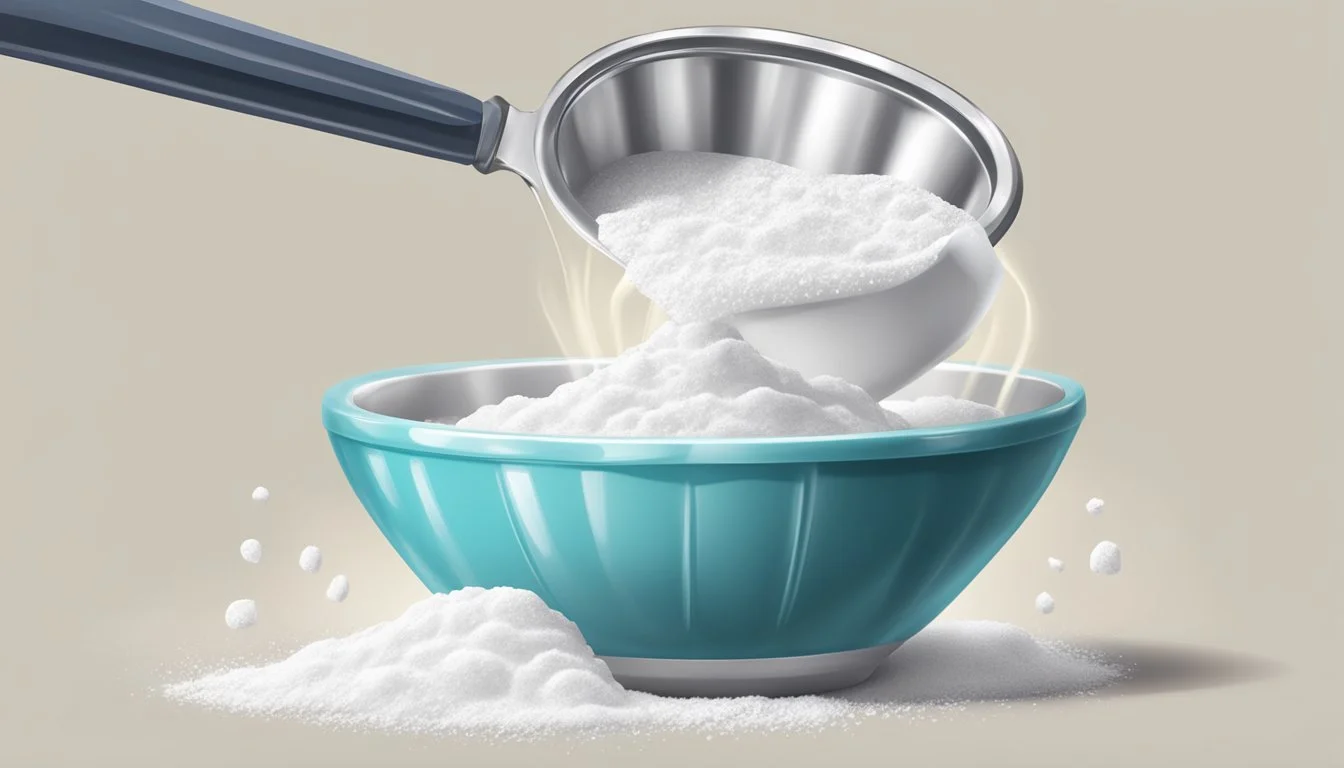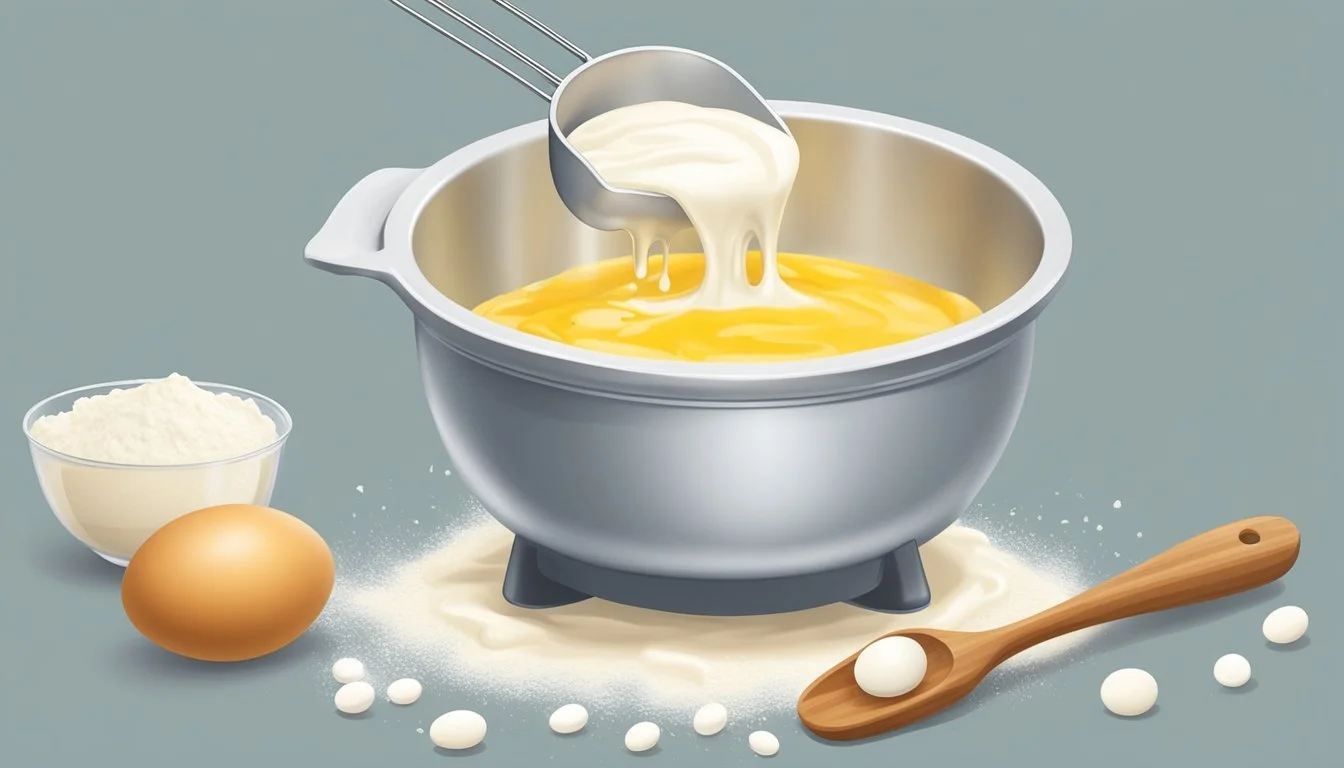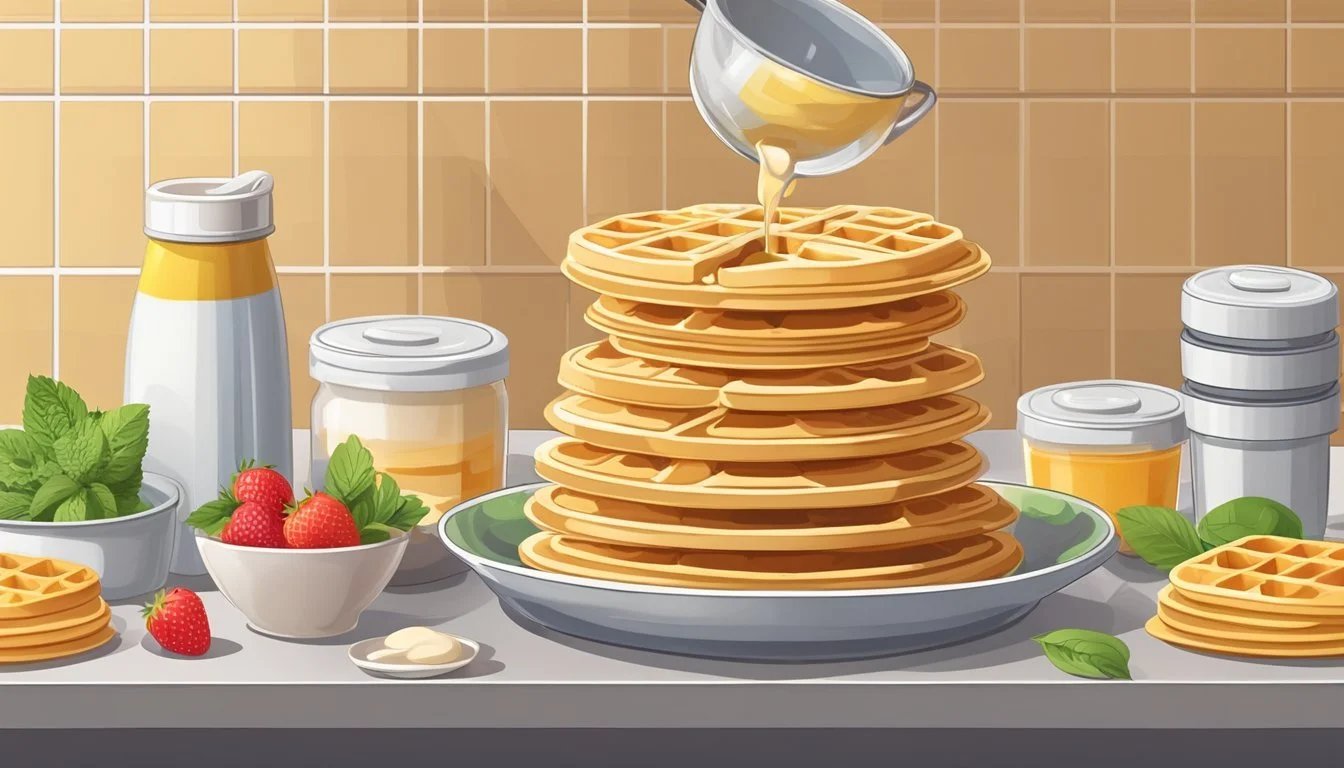How to Measure the Right Amount of Liquid for a Perfect Waffle Glaze
A Step-by-Step Guide
Achieving the perfect consistency for a waffle glaze calls for precise measurement of liquid ingredients. The texture and flow of the glaze not only affect the taste but also the presentation of the waffles. The right amount of liquid—often milk or water—is crucial to ensure the glaze drizzles smoothly over the waffle without being too runny or excessively thick.
When measuring liquids for a waffle glaze, one must consider the desired end result. A thicker glaze will stay atop the waffles with minimal dripping, ideal for a rich coating. In contrast, a thinner glaze will infuse the waffles with flavor while providing a glossy sheen.
To determine the perfect liquid-to-sugar ratio, one should begin with a foundational recipe and adjust according to texture. The method of pouring, whether spooned over or drizzled with a whisk, also influences the amount of liquid required. Precision in measurement ensures that each waffle is complemented with a glaze that highlights its taste and texture.
Understanding Liquid Measurements for Waffle Glazes
Accuracy in measuring liquid components is critical for achieving the desired consistency and taste in waffle glazes.
Importance of Precision in Liquid Measurements
Precise liquid measurements are essential for the success of waffle glazes. Even small deviations can alter the viscosity and flavor intensity of the glaze, leading to a suboptimal coating for the waffles. Measuring liquids accurately ensures the glaze adheres properly and offers an even taste experience with each bite. Moreover, it allows for consistent results across different batches, which is particularly important for those who sell or serve waffles professionally.
Tools for Measuring Liquids
The primary tool in a chef's arsenal for measuring liquids is the measuring cup. A clear glass or plastic cup with distinct markings in both milliliters (ml) and cups ensures accuracy. For smaller amounts, spoons ranging from a teaspoon (tsp) to a tablespoon (tbsp) are available and can measure liquid flavorings like liquid food coloring or extracts precisely.
When dealing with larger quantities or seeking greater precision, scales can be used to calculate the specific gravity—the ratio of the glaze's density compared to water. This measurement helps ensure the correct thickness of the glaze, particularly important for waffles, where a thicker glaze may be preferable for a richer taste. To measure specific gravity, a scale sensitive to at least 0.1 grams is recommended.
Waffle Glaze Basics
Crafting the perfect glaze for waffles involves precision and understanding the role of each ingredient. This section will explain the ingredients commonly used in glazes and their specific functions.
Ingredients Commonly Used in Glazes
The foundation of most waffle glaze recipes typically includes:
Powdered sugar: This is the primary sweetener and thickener for glazes.
Liquid components: Often milk or cream, which provides the glaze with its smooth consistency.
Flavoring: Vanilla extract is the most popular choice, adding a warm, classic flavor.
To enrich the glaze, one might also incorporate:
Butter: For a richer taste and glossy appearance.
Cream cheese: Adds a tangy flavor and creamy texture.
When measuring liquids for glazes, use standard measuring cups and spoons for accuracy. Here's a basic representation to guide you:
Ingredient Measurement (approximate) Milk or Cream 1-4 tablespoons Vanilla Extract 1/2 - 1 teaspoon
Remember, the quantity of milk or cream can vary to achieve the desired consistency—thicker for a frosting-like texture or thinner for a drizzle.
Function of Ingredients in a Glaze
Each ingredient in a glaze serves a specific purpose:
Powdered sugar: Dissolves easily without the need for heat, providing sweetness and structure.
Milk or Cream: Thins the glaze to the correct consistency for drizzling or spreading.
Vanilla Extract: Enhances the overall flavor without altering the viscosity.
Butter: When melted, it imparts a silky sheen and a delectable taste.
Cream Cheese: Its thick nature contributes to the body of the glaze while also adding a distinct flavor profile.
Adjusting the ratio of liquids to powdered sugar is crucial for achieving the right consistency, whether the glaze is intended to drizzle off a spoon or rest heavily atop the waffles. Typically, more liquid will lead to a thinner glaze, while more powdered sugar will thicken it.
Creating the Perfect Waffle Batter
Perfect waffle batter is the foundation for delicious waffles. The key is getting the right balance of ingredients and consistency for an ideal texture and flavor.
Waffle Batter Ingredients
For successful waffle batter, one must gather quality ingredients. Use all-purpose flour as the base for its versatility in creating both light and crispy waffles. The raising agents, typically baking powder and maybe baking soda, are essential for that characteristic fluffiness. The inclusion of a pinch of salt or kosher salt enhances the overall flavor profile.
Eggs contribute structure and richness, while buttermilk offers a tangy depth and additional leavening, thanks to its acidity. When making Belgian waffles, some recipes might call for a little more raising agent to achieve their notable puffiness. The below table lists the standard dry ingredients for a basic waffle batter:
Ingredient Amount All-purpose flour 2 cups Baking powder 2 tsp Baking soda 1/2 tsp Salt 1/2 tsp
Combining Wet and Dry Ingredients
To ensure even distribution, whisk the dry ingredients together before combining them with the wet. In a separate bowl, eggs should be beaten until fluffy before being mixed with buttermilk. Gradually incorporate the wet mix into the dry, using a folding motion to keep the batter light. Overmixing can lead to dense waffles, so mix just until the batter is combined with some small lumps remaining.
Adjusting Waffle Batter Consistency
The batter's consistency depends on personal preference and the desired outcome: thinner batter for crispier waffles, thicker for fluffier waffles. If the batter is too thick, thin it out with a touch more buttermilk. Conversely, if it is too runny, a sprinkle of flour can bring it back to the right consistency. It's not uncommon for the first waffle to act as a test to fine-tune the batter, so don’t hesitate to adjust as needed. Remember, the batter should pour easily but still hold its shape on the waffle iron.
Using a Waffle Iron
The quality of waffles produced hinges on correctly utilizing the waffle iron, which involves proper preheating, greasing, and handling of the batter during the cooking process.
Preheating and Greasing the Waffle Iron
Before pouring the batter, preheat the waffle maker to the desired temperature, usually around 365°F for standard waffles. Most Belgian waffle makers require a higher temperature to achieve a crispy exterior. Proper preheating leads to evenly cooked waffles and a reduced total time from prep to plate.
Greasing the iron is crucial to prevent sticking -- a little oil brushed or sprayed over the irons' surface ensures easy waffle release. Avoid butter as it may burn at high heats and non-stick sprays which can build up over time, possibly affecting the waffle iron's performance.
Pouring and Cooking the Batter
Pour the batter into the center of the iron using a measuring cup to ensure consistent sizing. For a standard waffle maker, 1/2 to 2/3 cup of batter is typically sufficient; however, amounts will vary based on the iron's size.
Cook time usually ranges from three to five minutes. If the waffle maker has an indicator light, it will signal when the waffles are done; without an indicator, watch for the steam to stop as a sign they are ready. Never open the waffle iron prematurely; doing so may interrupt the crisping process and lead to undercooked waffles.
Glazing and Topping Techniques
A successful glaze can transform ordinary waffles into a gourmet experience, and the right toppings significantly contribute to the overall flavor profile. Here, explore the methods of applying glazes to waffles and learn about adding extra toppings for enhanced flavor.
Applying Glazes to Waffles
A waffle's surface is perfect for capturing the richness of a well-prepared glaze. The following steps ensure a properly glazed waffle:
Choose Your Glaze: Select a glaze type, such as a simple maple syrup or a more elaborate cream cheese glaze. A cream cheese glaze, for example, can be prepared by combining cream cheese, powdered sugar, milk, and vanilla extract, then using a hand mixer until smooth.
Consistency Matters: For a fluid glaze that drizzles nicely, one should aim for a consistency that coats the back of a spoon. Using a whisk, mix until the glaze reaches a pourable viscosity without being too runny.
Apply the Glaze: Pour the glaze over hot waffles in a zigzag pattern to ensure even distribution. This can be done using a ladle for maple syrup or a piping bag for a thicker glaze like chocolate sauce or cream cheese.
By carefully whisking and applying the glaze, one creates both visual appeal and a delicious layer of flavor.
Extra Toppings for Enhanced Flavor
After glazing, waffles can be elevated further with a selection of toppings. Below is a guide to complementing the glaze with fresh and flavorful additions:
Fresh Fruit: Sliced strawberries, blueberries, and other berries add a fresh and tangy contrast to the sweet glaze.
Richness and Texture: For added richness, dollops of whipped cream or a scoop of strawberries and cream can provide both flavor and a pleasing mouthfeel.
A table with suggested topping combinations:
Topping Suggested Glaze Description Sliced Strawberries Chocolate Sauce Offers a classic chocolate and fruit pairing Fresh Berries Cream Cheese Glaze Balances creaminess with a burst of zest Whipped Cream Maple Syrup Adds a cloud-like texture to the sweet glaze
To maximize enjoyment, one should pair toppings and glazes that complement each other, taking into account factors like texture, sweetness, and overall harmony of flavors.
Serving and Presentation
When serving waffles with glaze, it is essential to consider the visual appeal and the nutritional balance. Striking the right balance enhances the dining experience, whether it's a special breakfast, Mother's Day brunch, or any gathering that features waffles as a brunch centerpiece.
Plating Waffles for Appeal
Presentation counts when plating waffles. A golden-brown waffle serves as a canvas; its pockets provide an ideal structure for the glaze to settle, creating an eye-catching pattern. To maintain this appeal:
Pour the glaze starting from the center, using a spiral motion going outward.
Garnish with fruit, mint, or a dusting of powdered sugar for color contrast and visual interest.
For a neat presentation, use a squeeze bottle or a ladle with a pouring lip to control the flow of the glaze.
Serving Sizes and Nutritional Information
When determining serving sizes, one needs to account for the glaze as part of the nutritional content of the dish. Here is a simple way to calculate and present this information:
Servings: A standard serving size for an adult includes one large or two small waffles.
Calories: Calculate the caloric content of the glaze by ingredient and add it to the calories of the waffle.
Component Serving Size Calories (Approx.) Waffle 1 large 200 - 300 Glaze 1 tablespoon 40 - 60 Total per serving 240 - 360
Adjust quantities and nutritional information based on specific recipes and dietary requirements. It's good practice to have this information easily accessible for guests.
Advanced Waffle Variations
Elevating the humble waffle to a gourmet level involves incorporating unique ingredients and pairing them with occasions that call for a special touch.
Experimenting with Flavors and Textures
An adventurous cook can transform classic, fluffy waffles into a standout dessert by experimenting with various add-ins and toppings. Incorporation of chocolate chips or chunks introduces a rich, gooey texture, while a sprinkle of walnuts adds a satisfying crunch. Red velvet waffles add a luxurious twist and a vibrant hue, making them an indulgent treat for both eyes and palate.
For those looking to recreate classic desserts, red velvet and chocolate waffles serve as excellent bases. Here is a simple way to integrate these flavors:
Red Velvet Waffles: Add cocoa powder and red food coloring to the batter, and top with cream cheese glaze.
Chocolate Waffles: Incorporate unsweetened cocoa powder and chocolate chips into the batter to achieve a deep chocolate flavor.
Textures can vary from light and airy to crisp and hearty. The key is to mind the balance of wet and dry ingredients and to avoid overmixing, which can lead to dense waffles.
Unique Waffle Recipes for Special Occasions
Special occasions call for waffles that go beyond the standard. Mother's Day, for instance, is the perfect opportunity to show appreciation with an elegant breakfast of pumpkin waffles—their warm spices and comforting texture make them a thoughtful choice for a fall celebration.
Below is a table that suggests unique waffle recipes suitable for some special occasions:
Occasion Waffle Variation Key Ingredients Suggested Toppings Mother's Day Pumpkin Waffles Pumpkin puree, cinnamon, nutmeg Whipped cream, maple syrup Valentine's Day Red Velvet Waffles Cocoa powder, red food coloring Cream cheese glaze, powdered sugar Chocolate Lover's Birthday Chocolate Chip Waffles Chocolate chips, cocoa powder Chocolate sauce, whipped cream
For each recipe, one should measure ingredients precisely to ensure the right consistency and flavors are achieved. The confidence in each bite comes from a meticulous approach to crafting these delightful treats.
Waffle Storage and Freshness
Proper storage techniques are crucial for maintaining the freshness and quality of leftover waffles. These methods help ensure that waffles retain their crispy texture and delightful flavor when preserved correctly and reheated with care.
Preserving Leftover Waffles
Leftover homemade waffles can be saved for later enjoyment with the right approach. For refrigeration, place the waffles in an airtight container and store them for up to 5 days to maintain freshness. Freezing offers a longer-term option; waffles can be frozen for up to 2 months. To freeze, it's important to:
Let the waffles cool completely to room temperature to prevent condensation.
Separate each waffle with parchment paper to avoid sticking.
Store in a sturdy, airtight container or resealable freezer bag.
Label the container with the date so you can keep track of storage time.
Reheating for Best Results
When it comes to reheating, careful methods should be employed to recreate the original crispy texture of homemade waffles. One should avoid the microwave, as it often leads to soft, limp waffles. Instead, use the following steps for best outcomes:
Preheat the oven to 350°F (175°C).
Place waffles directly on a rack for even heat distribution.
Heat them for about 5 minutes or until they're warm and crispy.
The oven mimics the dry heat of the waffle iron, so the resulting texture stays true to the original fresh-off-the-iron crispiness.
Frequently Asked Questions
In crafting the perfect waffle glaze, precision is key. This section addresses common queries relating to ingredient substitution and fixing minor issues in waffle glaze preparation.
Substituting Ingredients in Waffle Glazes
When substituting ingredients, it's essential to maintain the glaze's consistency and taste. If someone is out of cornstarch, they can use flour as a thickener but should double the amount; for every 1 teaspoon of cornstarch, use 2 teaspoons of flour. Substituting sugar types may alter the glaze's texture; fine sugars dissolve easier, offering a smoother finish. When considering low-calorie sweeteners, one must check the package to see if it is a 1:1 substitution or needs adjustment. For adding color, food coloring can be swapped with natural alternatives like fruit purees, but additional sugar or thickening agents may be needed to balance the wetness and sweetness.
Ingredient Substitute Ratio Cornstarch Flour 1:2 (teaspoon for teaspoon) Sugar Alternative sugars Check package for ratio Food Coloring Fruit Purees Adjust sugar/thickening as needed
Common Waffle and Glaze Troubleshooting
If a glaze is too thin, additional cornstarch or flour can be whisked in, starting with small increments, like a teaspoon at a time, until the desired consistency is achieved. Should a glaze become too thick, incrementally adding the liquid used in the recipe (such as milk or water) can help. If one's glaze tastes too sweet, adding a pinch of salt can help balance the flavor profile. In case the waffle batter itself is giving trouble, and the recipe is confused with a pancake recipe, remember that waffle batter typically contains more fat for crispiness. These tips can help ensure that both the waffles and the glaze turn out as expected.
Thin Glaze: Add cornstarch or flour in 1-teaspoon increments.
Thick Glaze: Gradually introduce more liquid.
Overly Sweet Glaze: Balance with a pinch of salt.
Waffle vs. Pancake Batter: Waffle batter should contain more fat.
Conclusion
In preparing the right amount of liquid for a waffle glaze, precision balances texture and flavor. The consistency of the glaze is pivotal; it should be fluid enough to spread but thick enough to adhere. A glaze too thin will run off, while one too thick may overpower the waffle. A common guideline is to aim for a viscosity similar to heavy cream.
Measurement Tips:
Use a kitchen scale for accuracy
Start with a base liquid measurement, then adjust as needed
Record ratios to ensure consistency in future preparations
Practical Applications:
Brush Application: A thicker glaze will suit this method.
Dipping or Pouring: A more fluid glaze is preferred.
A glaze's performance is also influenced by the ingredients' proportions, the mixing technique, and even the ambient temperature and humidity. Chefs should adjust the liquid content based on these variables to maintain the desired consistency.
Here's a basic proportion guideline:
Ingredient Proportion Powdered Sugar 1 cup Milk or Water 2-4 tbsp Flavoring to taste (1 tsp)
They must consider the outcome of the waffle glaze not only in terms of texture but also in how it complements the waffle's flavor. Experimentation can lead to the perfect balance, providing an enjoyable texture and enhancing the overall taste experience.










